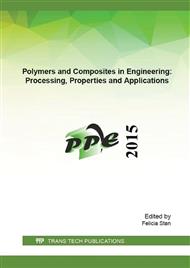p.31
p.37
p.43
p.49
p.57
p.63
p.71
p.80
p.86
Electrochemical Codeposition of UHMWPE Biopolymer into Cobalt Matrix for Biomedical Applications
Abstract:
The aim of this work was to obtain hybrid Co/UHMWPE composite biocoatings reinforced by UHMWPE (ultra high molecular weight polyethylene) biopolymer microparticles in the cobalt matrix, by electro-codeposition technique, with possibilities to use them as biomaterials. UHMWPE was selected as surface modifier element, due to its high biocompatibility and low coefficient of friction being used in many biomedical applications. Cobalt is already used in biomedical implants as cobalt – chromium alloys. The obtained coatings were investigated in terms of surface morphology (scanning electron microscopy - SEM), chemical composition and inclusion percentage (energy dispersive X-ray spectroscopy - EDX), roughness and microtopography (atomic force microscopy - AFM), coating thickness and microhardness. The SEM morphologies of electrodeposited pure cobalt and Co/UHMWPE composite biocoatings, show differences due to UHMWPE biopolymer particles incorporation in the cobalt matrix. The inclusion of UHMWPE microparticles increases with increasing the UHMWPE concentration in the electrolyte as was demonstrated by EDX investigations. The addition of the UHMWPE biopolymer microparticles to the deposition bath led to an increase of the roughness of hybrid coatings comparatively with pure cobalt coating obtained under the same conditions. The coating thickness of the electroplated surfaces as were observed by cross sectional scanning electron micrographs confirm higher adhesion strength of the coatings on the stainless steel support.
Info:
Periodical:
Pages:
57-62
Citation:
Online since:
July 2016
Authors:
Price:
Сopyright:
© 2016 Trans Tech Publications Ltd. All Rights Reserved
Share:
Citation:


